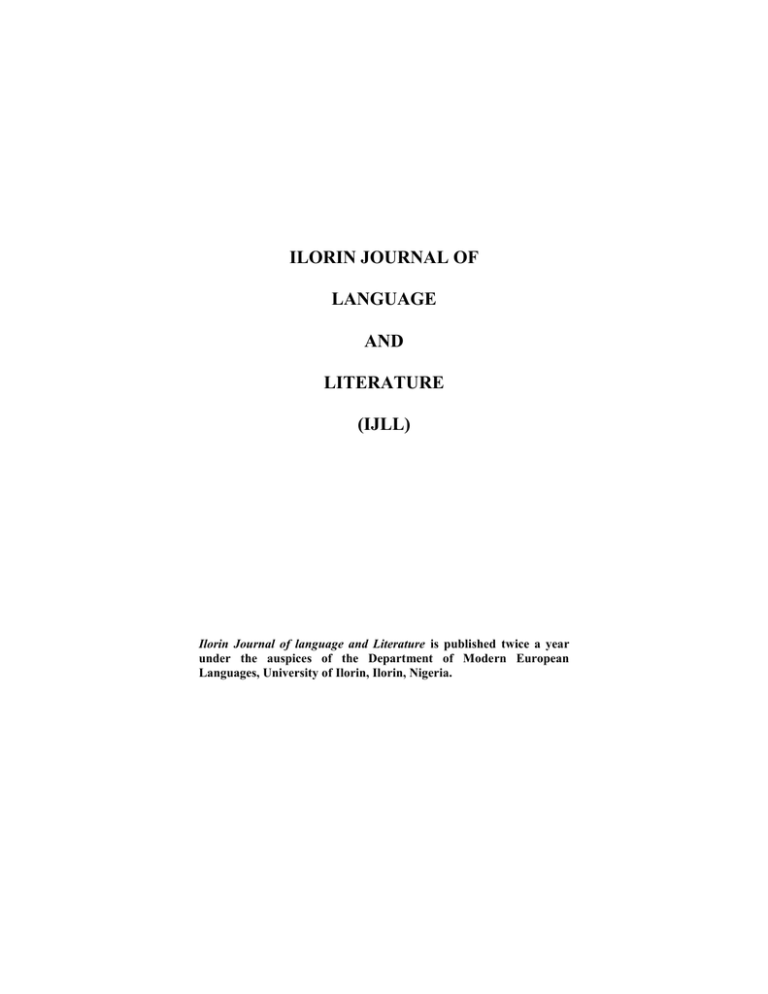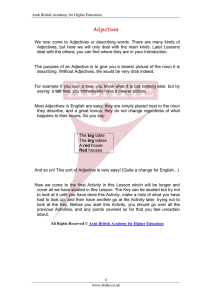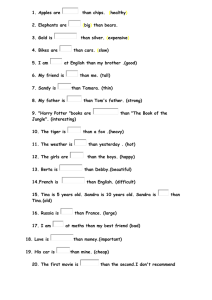ILORIN JOURNAL OF LANGUAGE AND
advertisement

ILORIN JOURNAL OF LANGUAGE AND LITERATURE (IJLL) Ilorin Journal of language and Literature is published twice a year under the auspices of the Department of Modern European Languages, University of Ilorin, Ilorin, Nigeria. TABLE OF CONTENTS 1. 2. 3. 4. 5. 6. 7. 8. 9. 10. On the French Adjectival Morpheme: Trice.............. 1 - Tunde Ajiboye The Voices and Rotes of Women in East African Literature…………………………………………….. 14 -V.U.Ola Words and Meanings: A Study of Patterns of Semantic Change in die English Lexicon................................... 26 — Efiirosibina Adegbija Une Critique de la Polygamie.................................... 38 — Matiu N. Nnoruka Dominance Configuration and language Planning in Nigeria......................................................................... 48 — Chinyere Nwahunanya La Structure Semanting D'une Texte: Vehi-Cosame De Sembene Oumane...................................................... 58 - P. N. Nwajeh The Society and Individual in Selected African Type.69 — Sam. A. Adewoye The Semantic Status of Metaphor............................. 81 — Kayode Omole Pidgin............................................................................ 89 — Charles Mam Analyse Linguistique D'un Texte De Bernard Dadie "Beatrice Du Congo" Présence Africaine................. 98 -J.K. Arogun ON THE FRENCH ADJECTIVAL MORPHEME: "-Trice" TUNDE AJIBOYE 1. Adjectival Inflection in French: In his now very familiar book, Analyse du francais parle (1972), Sauvageot seems to open up an old wound when he attempts an analysis of the grammatical gender of oral French. As if to remind us of the probable limits of a systematic, all-embracing account of this important grammatical feature, he cautions: "L’un des problèmes les plus délicats du français parle réside dans la détermination du genre grammatical", p. 66 ("One of the -most delicate problems of spoken French is in the determination of the grammatical gender".) translation by me. With special reference to the gender-governed inflection adjectives, Sauvageot's most significant contribution appears to be observation that it is the "forme longue" of the adjective that marks feminine gender. And there are several examples that go to justify observation: masculine feminine of his the the /iɔ͂/ /1ɔ͂g/ / fo / / fos / / bla / / blas / /VεR / / VεRt/ / gRi / / gRiZ / Yet, a critical examination of the behaviour of French adjectives makes it necessary to qualify Sauvageot's observation. Or how else could we deal reasonably with the following samples which do not show evidence of unequal length in both genders? /pybilk/ /pRatik/ /fatige/ /KRYEL/ — — — - /pyblik/ /pRatik/ /fatige/ /KRYEL/ 2 Ilorin Journal of Language and Literature The weight of the "written word", as it were, has also affected on discussions on adjectival feminisation so much that a description of this feature is often done via evidence provided by written French. This position is perhaps best illustrated by Dubois and Juannon's approach to the problem as contained in Grammaire et Exercises de francais. According to them, there is a general rule governing adjectival feminisation in French: add 'e' to the adjective in its masculine form. Because of the apparent workability of this rule, many teachers of French, oblivious of the oral implications of the rule get their pupils to commit to memory "le feminin se forme en ajoutant e au masculin." ("The feminine is formed by adding e to the masculine"). While adjectives like 'petit', 'commercial', 'national', 'joli', 'vrai', 'pointu' justify, from the graphic point of view, the rule proposed, the difficulties that arise when these adjectives are subjected to oral treatment, show the limits of the applicability of the rule, however popular. When other analyses attempt to take care of the oral medium and its effects on rule formation, such analyses are often beset by the danger of mixture of evidence — oral and written. Grevisse (1980) records his awareness of such a danger in Le Bon Usage (p. 368) where he warns: "La langue écrite donne une idée fausse des rapports que la langue parlee établit entre le masculin et le féminin des adjectifs. (The written language gives a false idea of the relationships established by the spoken language between the masculine and feminine forms of adjectives".) Several authors of text-books, including contemporary, ones, seem not to have heeded the warning which, in essence, calls for a separate study of the conditions for gender inflection of adjectives at the oral and written levels. One significant result is that the list of the so-called irregular cases is suspiciously long. Another effect is that a confusion of notions such as 'consonant' and 'vowel' becomes unavoidable. In Le Nouveau Bescherdle's Le Francois pour tous (1984), for instance, there is this rule on page 31: "Les adjectifs se terminant par les voyelles i, ai, u etc prennent un e au féminin". "Adjectives ending hi the vowels i, ai, u etc take e in the feminine". This rule, as rightly claimed,, is satisfactory for a good category of adjectives processed through the written medium, but it suffers severe cautions when applied to me oral medium as it is men limited to adjectives whose masculine "se termine par une consonne". The limitation of this 3 Ilorin Journal of Language and Literature rule, as carefully worded as it is, is obvious as the use of 'consonant’ and 'vowel' seems not to take adequate account of the speech mediums, to which they are being applied.. To be less clumsy, the use of toe terms 'consonant' and 'vowel' should be able to show a clear understanding of the ambiguity status of these terms such that when perceived hi articulately terms, they command a different perspective from when they are conceived of as graphic symbols. In effect, some of the so-called vowels e.g. ai, u have different meanings according to whether our perspective is graphic or phonetic. For example, 'ai' does not exist as a vowel sound in French, while 'u' as a letter corresponds to the sound /y/. This is where Sauvageot's attempt to describe spoken French is a courageous contribution to the effort towards a separate study of oral and written French in all their ramifications: 2.00 Valdman's Contributions: Sauvageot's conclusion regarding the delicate character of gender-governed inflection in French must have been in recognition of an earlier contribution by Valdman (1970) who suggests that, as an improvement of the structuralist approach to the problem of adjective inflection generally (i.e. in terms of number and gender), the transformational formulation be tried. Reviewing first of all the structuralist approach in Bloomfield's analysis of French adjective inflection, Valdman agrees that using the feminine form as the base may well provide a satisfactory solution to the problem of "irregularities" but remarks the inadequacy of the model in dealing with the variations occurring with adjectives in pre-nominal positions. In other words, the structuralist approach has not accounted for the phonological variations imposed by context. It is not sufficient, argues Valdman, to know that 'petite' is the feminine form from which masculine 'petit' is derived, or that the terminal consonant III in 'petite' represents a minus-feature characteristic of all masculine adjectives in that class. It is equally useful to note that /petit/ could, in given contexts, signal the masculine condition. This is particularly true of liaison contexts: 'petit ami' /patitami/; 'petit inteiet'/petit -fitere One could add that it is not only with pre-nominal adjectives that such minute complexities have to be observed; the same feature is also noticeable with adjectives in postnominal positions where the zero mark recorded for pluralisation contrasts sharply with /z/ mark in pre-nominal contexts where liaison is indispensable: 4 Ilorin Journal of Language and Literature Compare: les grands h£ros / le gRá eRo/ and les grands hommes / le gRazɔm/ A second criticism of the structuralist approach to adjective inflection, according to Valdman, is that it fails to explain in any concrete way why, in a given environment, the adjective should have a particular form. While it is fairly easy to state, for example, that, for the so-called class 1 adjectives, the final consonant is dropped, it is not at all easy, from Bloomfield's analysis, to account for the difference in the form of the consonants dropped in one context and that dropped in another. Why is it that /S/ goes for /bla/ and /g/ for /'5/and not the other way round? There is yet a third criticism. The approach "fails to explain ... the replacement of the final consonant in the masculine singular prevowel form: /lɔ̋ by /lɔ͂k, /gRã/ by /gRãt/..." This is a clear reference to the liaison feature in French. Now, relying on the transformational model proposed by Valdman himself, one could summarise the process of adjectival feminisation as follows: Base form + Fern. This implies (1) that the masculine and the feminine forms are derivable from the same deep base (2) that masculinisation is signalled by zero. Thus, 'pursues Valdman , "the base of a French adjective is neither masculine nor feminine, although its, representation in the spelling is equal to the representation of the masculine singular in as much as the latter Consists of the base + zero." (p. 614, op cit.). Two classes of adjectives are recognised here, depending on how they end. Class 1 adjectives are (a) those that end in mute V like: stupide, simple, dole, pratique; (b) those that end in stable vowel: carre', joli, (c) those that end in stable consonant: seul, clair. Class II adjectives are those that end in latent consonant: petit, gros, gris, gras. Applying various rules such as elision, liaison, nasalisation, nasal vowel adjustment, mid vowel adjustment, voicing shift rules, the author arrives at a largely satisfactory model of analysis of what happens when French adjectives are changing gender. The number of exceptions is largely reduced to what he has called idiosyncratic cases such as /fɔl/ /vjεij/ /bεl/ /sεf/ favoRit/. Ilorin Journal of Language and Literature 5 3.00 Adjectives in-trice However, the various attempts described so far, aimed as they are at discovering a pattern for adjective inflection in French, seem to have left untouched or failed to adequately account for feminine adjectives in- trice. A brief look will be given to attempts made so far to explain the conditioning of -trice, while their major defects or inadequacies will be highlighted. Later, we shall propose a model (based on the structuralist tradition) which, in our view, should be able to account more satisfactorily for the occurrence of -trice. That -trice is a morphemic variant in French adjectival feminisation is not in doubt. What is not clear or, at least debatable, is how to explain its positioning and detailed process of derivation. The various accounts provided (where there is any account) have crystallised in one major view: that -trice is the feminine off-shoot of -teur. For example, Martinet1 states as follows: "Les M en-teur ont des F en-trice" In the same way, Ferrar2 declares as follows: "Many words in-teur have their feminine in-trice". Examples abound as illustrative evidence: accusateur conservateur corrupteur civilisateur centralisateur rénovateur évocateur : : : : : : : accusatrice conservatrice corruptrice civilisatrice centralisatrice rénovatrice évocatrice This view has, nonetheless, led to much confusion, especially among foreign students since, without a clear idea of what has determined the morpheme boundary, they often have difficulty dealing with forms like 'flatteur', 'menteur', 'prometteur', 'rapporteur', 'consulteur' all of which apparently all end in -teur and therefore should admit -trice! And when they are told that 'menteuse' goes with 'menteur', (and not 'mentrice'), •flatteuse' with 'flatteur' (not 'flattrice'*) and so on, their distrust is hardly unjustifiable. The question now is: how do we distinguish between the two -eur contexts, if we are persuaded that there is something fundamentally different about them such that one context attracts -trice and the other -euse? 6 Ilorin Journal of Language and Literature In an attempt to solve this problem, linguists have preferred to class the trice-attracting adjectives as derivable, form 'special' rules or describe them categorically as irregular, therefore exceptional. This position could be attributed to Valdman. Grammar textbook authors, quite understandably anxious to simplify matters for their prospective students, have come up with attractive, albeit disputable observations. One of the most characteristic observations will be studied here. It consists in positing that to have -trice, the stem of the adjective must not be that of the present participle. This is not an insignificant contribution to the gallaxy of ideas that are associated with reasoning out a pattern for'-trice. The observation seems justified, if we compare, as Ferrar has suggested, 'danseur — danseuse' with destructeur — destructrice. 'Whereas for 'danseur' we can isolate dans- of 'dansant', in 'destructeur, partly because 'eur' is preceded by 'ct', we cannot neatly isolate d&rui- of 'd6truisant'.. Even in the case of menteur -menteuse, where the 't' seems to predispose us to derive 'mentrice the fact that we could get the stem of the present participle ment- without violence' done to the original form would appear to strengthen the observation being considered. But further evidence weakens this observation a great deal, as we shall soon demonstrate. This approach, good as it may sound, suffers from three weaknesses. (1) It is not clear why the present participle which belongs to a different categorical group from that of the adjective, should be an indispensable base for deriving the inflectional variation of the latter. Would it not have been more convincing to have the present participle contributing to the syntactic status of the verb or other segments closely related to the verbal group? The case of the present subjunctive which some scholars believe to be derivable from the present participle would tend to justify one's claim about the way in which derivation of the imperfect from .the nous-form of the present incative, the derivation of the future from the infinitive, etc all point to the urge to see the role being ascribed to the present participle in -trice inflection as being, though compelling, suspect. (2) The second weakness is the failure of the approach to observe morphological synchrony. If the claim is that -teur changes to -trice, by virtue of the absence of the present participle stem, is it not possible to imagine that we are dealing not with -teur but with eur? Let us consider the following examples from that point of view: 1. 2. 3. 4. instituteur directeur conducteur moralisateur — — — — institutrice directrice conductrice moralisatrice 7 Ilorin Journal of Language and Literature Each would end as -trice in the feminine, given the condition of absence of the present participle stem. But when we examine what remains of the stem, we are obliged by our experience of French to identify destruct-, direct-, conduct-, moralisat-, for it is this identification that contributes to our decision to see the stem as not belonging to the present participle. In that case, our adjectival morphemic pair would be -eur -rice. Secondly, while our .knowledge of French encourages us to reject the stem as not resembling the present participle, it forces us at the same time to see the stem as close to one other syntactic form in the language: verb-derived \ noun in -ion/destruction) construction, "animation," fondation; 'protection etc. 3) The third weakness inherent in the approach is that it emphasizes absence rather than presence of a determining feature. That is to say that rather than explain the data either in absolute terms without external reference or see die data as embodying a feature .Which, upon examination, is indispensable to analysis, this approach seems to establish a minus-feature whose structural relevance to the problem in question, as we have attempted to show, is not too evident. Does this approach not suggest strongly but, in a misleading way, mat the present participle (plus or minus) is cardinal in the treatment of adjectival inflection? The strength of a rule lies in its ability to account for as many cases as possible, leaving only few for idiosyncratic or historical treatment. Looking at the minus-present-participle-stem approach from this angle, one finds that! the behaviour of a number of adjectives spring uncanny surprises. A good example is 'emetteur' which, in spite of the fact that the present participle stem 6mett/ant is discernible, has 'e'mettrice' rather than 'emetteuse' in the feminine. In the spirit of the rule, 'e'mettrice' ought to be impossible since -trice-ending feminine adjectives are supposed to be associated with the absence of the present participle stem. Is 'e'mettrice' then an exception? If it is, what is the condition for its exceptionality? Grevisse, attempting to ward off the danger of the rule weakening on such a score, points out: "Un nombre considérable d'adjectifs en-teur, dont on ne peut tirerdes participes présents en changeant — eur en -ant (sauf exécuteur, persécuteur dont on peut tirer exécutant, persécutant), font leur feminin en-trice' Le Bon Usage, p. 376 ("A considerable number of adjectives-in-teur, from which one cannot derive the present participle by changing -eur into -ant (except executant, persecutant), have their feminine in-trice.") My translation. 8 Ilorin Journal of Language and Literature This remark which rightly makes provision for exceptions is still ambiguous; while it is clear that from 'executer' and 'persecuter', we could derive 'executant' and 'persecutant' respectively, it is not entirely clear whether, for that reason, 'exucuteur' and 'persecuteur' should be inflected 'executeuse', 'perse'cuteuse' respectively, like 'menteuse', 'trompeuse' etc or whether their exceptionality resides in their being inflected in -trice despite their stem, since Grevisse does not indicate the form of the processed output.3 If we are left to take a cue from the behaviour of 'ametteur', the prediction would be that 'executeur' and 'pers6cuteur' will receive -trice inflection. In that case, the rule rather than being strengthened by Grevisse is further weakened by two additional counter-evidences. 4.00 The -ion nominal as model: In order to reduce ambiguities and the list of potential irregularities, it is proposed that the system which will be suitable for dealing satisfactorily with -trice as an adjectival morpheme should take into account the following hypotheses: (a) that the stem of the adjective is relatable to that of the nominal in -ion; (b) that the adjective in question has passed through nominalisation by deverbalisation; (c) that this adjective is therefore an action-adjective. Unlike the stem of the adjective in -euse, the stem of the adjective in -trice is to be conceived of as stemming initially from the verb, which is nominalised. It is to this twin process that the adjective owes its present morphological complexion. The process may not leave an obvious mark-on the form of the stem. But when it does, the discovery procedure is easier. Let us consider the process hi stages: Stage 1 (Deverbalisation4/Nominalisation) a) corrompre — b) consoler — c) protégger — d) interroger — e) détenir — f) executer — g) persecuter — corruption consolation protection interrogation detention execution persecution. 9 Ilorin Journal of Language and Literature (Notice the role of the nominaliser 't' in the nominalisation process) Stage II (adjectivisation) 1. Isolate -t- as nominaliser and -ion as nominal suffix. 2. Apply the coalescence rule which allows the bound morphemes, each reminiscent of a definite syntactic status of the adjective hi its evolution, to be strung together. Examples: 3. corrup-t-ion — corrupt-lion consola-t-ion — consola-tion Apply permutation rule to replace -tion by -teur, as in the following examples: corrup-tion — -teur deten-tion — -teur execu-tion — -teur Stage III (feminisation) 1. feminisation rule: rewrite -teur as -trice The whole procedure could be formalised as follows: 1. Noun base + t + ion 2. Noun base + tion 2. Noun base + tion 4. Noun base + teur 5. Noun base -h teur 6. Noun base + trice (fern, context.) It is reasonable, to treat -teur (and therefore -trice) initially as two bound morphemes t-eur, t-rice respectively because without -t-, nominalisation in-ion through deverbalisation cannot occur in French. The idea of seeing -eur as a separate morpheme from -t- is further buttressed by the fact that in French, except for -ment, nominalisation by suffixation generally carries a vowel — initial suffix: — — — — age: marri-age, echaffaud-age, rod-age, us-age ade: promen-ade, noyade ure: us-ure, bruhire ance: croy-ance, espe'r-ance, If we compare the behaviour of 'menteur' with that of 'persecuteur', for example, the difference in feminine adjectival inflection would be justified on the following grounds: that 'mentir' from which we derive 10 Ilorin Journal of Language and Literature 'menteur' does not get nominalised through the nominaliser -t- and hence does not realise its nominalisatipn in -ion. From 'mentir', we derive 'mensonge' and not 'mention'; but from 'persecutor' we derive 'persecution'. It is therefore valid to take the 't' in 'menteur' as being morphologically different from the 't' in 'persecuteur', hence the difference in their inflection. The importance of the existence of the nominaliser -t- in all -ion nominalisations with latent power of adjectivisation is made all the more glaring when it is remembered that verb forms which undergo nominalisation are supplied with -t- where it is not already in existence: deten[ir] — déten[t] usurp[er] — usurpa[t] institu[er] — instituft] observ[er] — obserw[t] In summary, the adjective that will attract -trice (1) must be a verb-derived adjective (2) must have die nominal stem of -ion (3) must carry in its stem a nominaliser -t- or any graphic form that yields the same phonetic result as 't' in /jS/ contexts. When these conditions are not satisfied, the coalescence of tand -eur which is indispensable for -trice inflection cannot occur. This is why in the case of 'flatteur', 'prometteur', 'nienteur', 'rapporteur', the feminine morpheme is -euse and not -trice. Let 'us bear in mind also that the attempt here takes for granted knowledge of the detailed process of nominalisation by deverbalisation. Moreover, because such a detail is not germane to the solution of the problem being discussed, it has not been considered necessary to analyse the hidden rules behind the morphological modifications that take place before such verbs as 'consoler', 'interroger,' 'civiliser', 'modeler', 'proteger', 'detruire' become nominalised. We should also note that the three-step procedure: verb-noun-adjective is important to our final /judgment on -trice for two reasons: 1. it allows us to explain more convincingly the derivational process associated with adjectives like 'dmetteur' which, of the nominal — 'emetteur' taken at the level of the nominal _ 'emission' alone, may be structurally difficult to explain; 2. the quality of the adjectives as action-adjectives whose target goes beyond the speaker is only successfully realised when these adjectives are first related to their verbal stem. 11 protecteur centralisateur provocateur perturbateur Ilorin Journal of Language and Literature — qui a le propre de proteger quelqu'un — qui a te propre de centraliser quelque chose — qui a le propre de provbquer quelqu'un on — qui a le propre de.perturber quelqu'un/ quelque chose Compare: malade ) commun ) all characterised by a definition of the state of the subject direct ) or referent only. silencieux) The approach proposed here raises an initial problem for 'dmetteur' which in the feminine, is realised as 'dmettrice'. If part of the obligatory conditions for -teur -trice realisation is the presence of a nominaliser -t- at the nominal base, the fact that 'emettre' gives 'emission* and not 'eminition' should raise some anxiety for our analysis. Yet, when we realise that the phonetic manifestation of the nominaliser t- when followed by -ion is the same as that of-ss- in the same context; the anxiety becomes subdued. In other words, the 'ss' of 'emission' has the same articulatory value as -t- in the context of -ion. This would then mean that, in principle, verbs like 'omettre', 'commettre', 'admettre' are verbs which, thanks to nominalisation, are realised as 'omission', 'commission', 'admission* respectively, and which some day, could be adjectivised as 'ometteur', 'commetteur', 'admetteur', even though they are not yet attested in the language. Conclusively, only enchanteur will, by this model, be treated by idiosyncratic rules. ' Finally, just like the case of 'enchanteur' is additional evidence that not all surface forms in -teur may attract -true, not all cases of nominalisation through deverbalisation and in -teur. Other possibilities are to be kept in mind: 1) -if recevoir réception réceptif decevoir déception déceptif décider décision deceptif posséder possession possessif 2) -el excepter exception exceptionnel senser sensation sensationnel 3) -aire confronter confrontation confrontataire Contester contestation conteslataire 12 Ilorin Journal of Language and Literature 5.00 Nouns in -trice: It should be possible to deal with nouns whose feminine is in trice in the same way as we have discussed above with respect to adjectives. The first insight has been provided by many an author who have put together for common study nouns and adjectives in -trice, (cf Ferrar, op. cit). This arrangement appears justified but not entirely, as nouns in -trice seem, in spite of surface similarities with the adjectives of the same suffixation, to behave in a way fundamentally different from the way adjectives do. Whereas it is true that the 3-step procedure is suitable for practically all so-called action-adjectives, and that where the -teur adjective cannot be derived from the nominal in -ion, -euse will be the result, only a set of nouns would behave along those lines. For example, 'tuteur', 'spectacteur', 'be'ne'facteur', 'aviateur', -end in the feminine in trice but they have no clear verbal derivative, unlike 'acteur', 'promoteur', 'r£dacteur', 'examinateur', 'conspirateur', whose verbal derivatives are 'agir', 'promouvoir', 'r^diger', 'examiner', 'conspirer' respectively. Another point to note is that whereas verbs like 'agir', 'r6diger' confirm the possibility of -ion nouns yielding -teur/ -trice, the examples of 'examiner', 'dessiner', show that unlike the adjectival counterpart -teur/ -trice nouns are not confined to deverbalised -ion nominals. This is to say that, synchronically, the passage from 'examiner' to 'examinateur' is not through 'examination' but, if anything, through examen. This tends to suggest that the rules governing the nouns in -teur/ -trice are probably more complex than those we have discussed so far in respect of adjectives. A further source of similarity between the noun and the adjective should, however, be noted. Verb-derived adjectives like 'promoteur', 'flatteur' whose nominalised variant is not in -ion have -euse in the feminine, apparently under the same morphological conditions. This is but an incomplete picture of the question-of determining the specific conditions for -trice inflection in exclusively nominal contexts. A further and more painstaking look at the morphological pattern of the French noun should be able to yield a result comparable hi depth to that being advanced in respect of adjectives. 13 Ilorin Journal of Language and Literature Notes 1. 2. 3. 4. A. Martinet La Grammaire Fonctiomelle du Francois. Didier (1979) p. 77. H. Ferrar: A French Reference Grammar. Oxford University Press (1967) p. 149. My attention has just been drawn to one of the books co-authored by Grevisse and Goose: Nouvelle Grammaire Francaise p. 93 where a position in favour of executeuse, persecuteuse has been taken Notice that deverbalisation is not an end in itself but a means to an end. It is to be seen as a necessary step towards nominalisation. Bibliography 1. 2. 3. 4. 5. 6. 7. 9. 10. 11. 13. 14. 15. 16. Ajiboye Tunde (1986): L'adverbe en -ment: une étude morphophonemique. Cahiers ivoirens d'Etudes Linguistiques, pp. 97-110. Dubois J et G. Juannon (1956). Grammaire et Exercices de Francois Larousse. Ferrar H. (1969): A French Reference Grammar. O.U.P. Grevisse, M. and A. Goose (1980): Nouvelle Grammaire Française. Duculot. Grevisse M. (1980): Le Ban Usage. Duculot (11th Edition). Hutchinson, J.A. (1969): 'Le desordre des mots, la place de 1'adjectif Le François dans le monde, 11: 1-2, pp. 155-183. Martinet, Andre1 S. (1979): Grammaire fonctionndle du François. Didlei. Manger G. (1968): Grammaire du François d'aujourd' hui. Hachette. Mitterrand Henri (1979): Grammaire active du François. N.B.A. Fernand Nathan. Mok, Q.I.M. (1968): Contribution a I'etude des categories morphologiques du genre et du nombre dans le français parle actuel. The Hague. Mouton. .2. Le Nouveau Bescherelle (1984): La Grammaire pour tous. Hatier. Sauvageot, Andr6 (1972): Analyse du français parle. Hachette, Paris. Schane S. (1968): French phonology and morphology. Cambridge M.I.T. Press. Valdman A. (1970): 'Competing models of linguistic analysis: French adjective inflection', French Review, 18: 4, pp. 606-23. Wagner, R.L. et J. Pinchon (1962): Grammaire du francais, Hachette.




